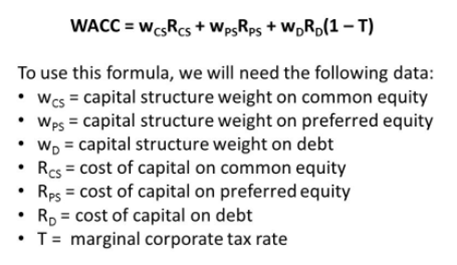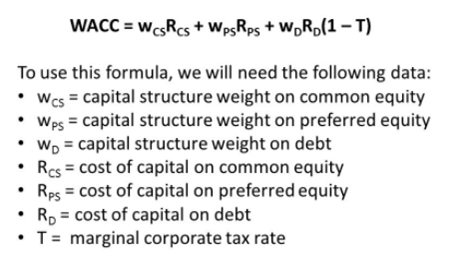•Money
used to start or run a business.
•Weighted
average cost of capital (WACC) is a calculation of a firm's cost of capital in
which each category of capital is proportionately weighted.
•All
sources of capital, including common stock, preferred stock, bonds and any
other long-term debt, are included in a WACC calculation. A firm’s WACC
increases as the beta and rate of return on equity increase, as an increase in
WACC denotes a decrease in valuation and an increase in risk.
•Debt
and equity are the two components that constitute a company’s capital funding.
Lenders and equity holders will expect to receive certain returns on the funds
or capital they have provided. Since cost of capital is the return that equity
owners (or shareholders) and debt holders will expect, so WACC indicates the
return that both kinds of stakeholders (equity owners and lenders) can expect
to receive. Put another way, WACC is an investor’s opportunity cost of taking
on the risk of investing money in a company.
Variables
Needed to Calculate WACC
WACC
Example
Sanstreet, Inc. went public by issuing 1 million
shares of common stock @ $25 per share. The shares are currently trading at $30
per share. Current risk free rate is 4%, market risk premium is 8% and the
company has a beta coefficient of 1.2.
During last year, it issued 50,000 bonds
of $1,000 par paying 10% coupon annually maturing in 20 years. The bonds are
currently trading at $950.
The tax rate is 30%. Calculate the
weighted average cost of capital.
WACC
Example
First we need to calculate the proportion
of equity and debt in Sanstreet,
Inc. capital structure.
Current Market Value of Equity =
1,000,000 × $30 = $30,000,000
Current Market Value of Debt = 50,000 × $950 = $47,500,000
Total Market Value of Debt and Equity = $77,500,000
Weight of Equity = $30,000,000 / $77,500,000 = 38.71%
Weight of Debt = $47,500,000 / $77,500,000 = 61.29%
WACC
Example
•Now,
we need estimates for cost of equity and after-tax cost of debt.
•
•We
can estimate cost of equity using either dividend discount model (DDM) or
capital asset pricing model (CAPM).
•
•Cost
of equity (DDM) = expected dividend in 1 year /current stock price + growth
rate
•Cost
of equity (CAPM) = risk free rate + beta coefficient × market risk premium
•
•In
the current example, the data available allow us to use only CAPM to calculate
cost of equity.
•Cost
of Equity = Risk Free Rate + Beta × Market Risk Premium = 4% + 1.2 × 8% = 13.6%
•
•Cost
of debt is equal to the yield to maturity of the bonds. With the given data, we
can find that yield to maturity is 10.61%.
•
•For
inclusion in WACC, we need after-tax cost of debt, which is 7.427% [= 10.61% ×
(1 − 30%)].
WACC
Example
WACC
= 38.71% × 13.6% + 61.29% × 7.427% = 9.8166%


